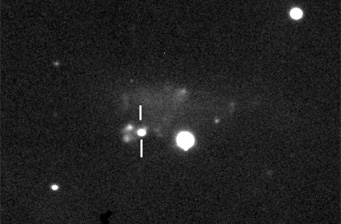| Update January 27: The supernova, now dubbed SN 2012A, seems to have reached a maximum brightness of about magnitude 13.4, which should be visible through moderate-sized amateur telescopes once the Moon is out of the way. See the Bright Supernova website for more information. The explosion has been classified as a Type II supernova, caused by the core collapse of a massive star. Also, in recognition of his long-running search for supernovae, the American Astronomical Society has given Puckett its 2012 Chambliss Amateur Achievement Award. See Shweta Krishnan's story here. |

The discovery image, taken January 7, 2012, of a 14.6-magnitude eruption (marked with lines) in the irregular galaxy NGC 3239.
Puckett Observatory Supernova Search
Several professional astronomers at the meeting have already started putting out e-mails and calls for spectroscopic observations. They hope to catch the supernova early and gain important information about what kind of explosion it is and, perhaps, what its progenitor was. Nothing shows up at this position in images taken by Puckett two weeks ago — at least, nothing brighter than magnitude 19.
For now, the object’s designation is PSN J10250739+1709146. There's more info at the International Astronomical Union’s Central Bureau for Astronomical Telegrams.
NGC 3239 is roughly 30 million light-years away (estimates vary), in the constellation Leo. Puckett notes the object's position as 24.65 arcseconds east and 16.1 arcseconds south of the galaxy's center. You also can get a sense of the object's location in this image by Australian amateur Joseph Brimacombe.
By the way, Puckett's supernova search, begun in the 1990s, involves amateurs in several countries and has more than 200 discoveries to its credit.
 0
0
Comments
You must be logged in to post a comment.